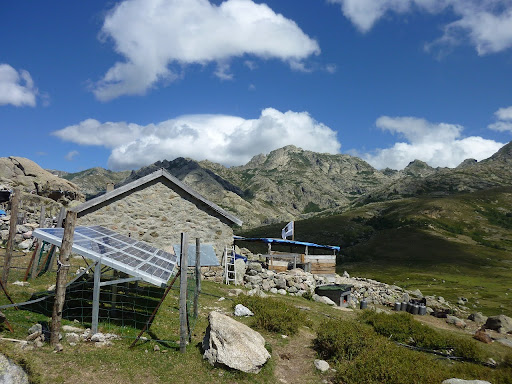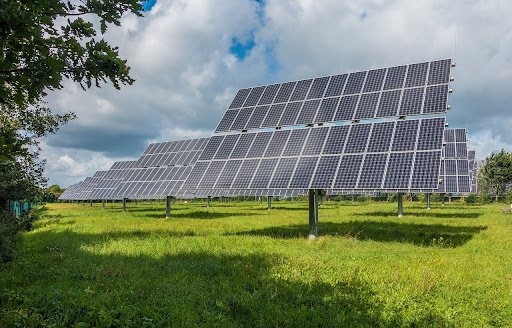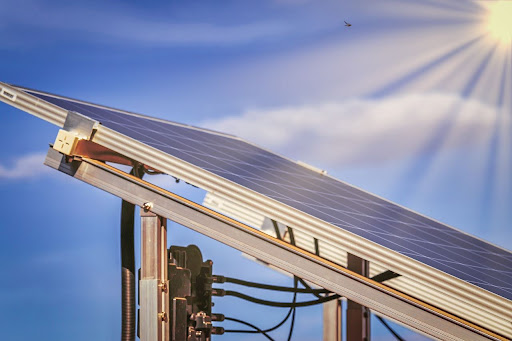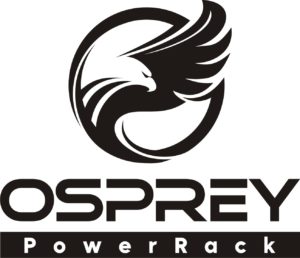Key Takeaways
- The latest ground-mount solar systems use advanced mounting technology to enhance efficiency and durability.
- Adjustable and modular racking systems allow for quick and easy installation, reducing labor costs.
- Cutting-edge materials increase the lifespan and performance of solar panels.
- Innovations in solar technology are leading to better energy production and reduced environmental impact.
- Nuance Energy’s Osprey PowerRACK® utilizes patented earth anchoring technology for faster, more efficient installations in different terrains.
Innovations in Solar Power Ground-Mount Systems
Advanced Mounting Technology
Advanced mounting technology is designed to improve the stability and performance of solar panels, ensuring they can withstand various environmental conditions.
For example, Nuance Energy’s Osprey PowerRACK® is an innovative system that uses earth anchor foundation technology. This approach eliminates the need for traditional foundations, which often require extensive ground preparation and skilled labor. Instead, the earth anchor technology allows for rapid installation using only handheld tools, significantly reducing both time and costs.
Adjustable and Modular Racking Systems
Adjustable and modular racking systems allow for precise alignment and optimal tilt angles, maximizing energy production. The modular design also simplifies the installation process.
Besides that, these racking systems are adaptable to various terrain types, providing a stable and secure foundation without the need for extensive ground preparation.
Durable Materials
Materials in new, advanced systems are designed to withstand harsh weather conditions, reducing the risk of damage and extending the lifespan of the solar installation.
For instance, some systems now incorporate corrosion-resistant coatings and high-strength alloys, ensuring the panels remain stable and secure even in challenging environments.

Resilient materials enhance the durability of solar panels allowing for installations across various terrains and harsh weather conditions.
Improved Accessibility and Maintenance
Modern ground-mount systems come with improved accessibility and easier maintenance – this means that both homeowners and commercial operators can maintain their solar installations with minimal effort.
The design of these systems often includes features such as tilt mechanisms and adjustable racks, which allow for easy cleaning and servicing of the solar panels. This ensures optimal performance and extends the lifespan of the system.
| Nuance Energy is your superior solution for ground-mount solar. Our patented foundation technology Osprey PowerRACK® allows for rapid installation using only handheld tools, significantly reducing both time and costs compared to traditional racking systems. This cutting-edge technology works for residential and commercial installations, and Nuance Energy empowers solar installers to take back control of their installation schedules, control project COGS, gain market share, increase the speed of installation, and reduce the cost of labor. In contrast, a traditional ground-mount is much more unpredictable, slower, and costly.
Find out how Nuance Energy can accelerate your solar projects with the Osprey PowerRACK® line, and boost your profitability. Contact us today to discuss our innovative ground-mount solutions. |
Types of Ground-Mount Systems
Fixed-Tilt Systems
Fixed-tilt systems are among the most common types of ground-mount solar systems. As the name suggests, these systems are set at a fixed angle, optimized to capture the maximum amount of sunlight throughout the year. They are simple, cost-effective, and require minimal maintenance.
Fixed-tilt systems are ideal for areas with consistent sunlight exposure and are a practical option for many users due to their simplicity and reliability.

A single-pole ground-mount solar system offers easy maintenance, optimal sun exposure, and efficient use of space.
Single-Axis Tracking Systems
Single-axis tracking systems take solar energy production to the next level by allowing panels to follow the sun’s path across the sky. This movement increases the amount of sunlight captured, thereby boosting energy output. These systems are particularly beneficial in areas with significant sunlight variation throughout the day.
Dual-Axis Tracking Systems
These systems adjust both vertically and horizontally to follow the sun’s trajectory, ensuring optimal solar capture at all times. This results in higher energy yields compared to fixed-tilt and single-axis systems.
While dual-axis systems offer superior performance, they also require more complex installations and maintenance. Therefore, they are best suited for larger commercial projects where the increased energy output justifies the additional costs.
| Tracking System Type | Pros | Cons |
| Single-Axis Tracker | Increases energy production | Higher initial costs |
| Requires less space | Limited tracking capability | |
| Easier maintenance | Less efficient than dual-axis | |
| Dual-Axis Tracker | Maximizes sunlight capture | Most expensive option |
| Higher efficiency gains | More complex installation | |
| Better performance in all seasons | Requires more maintenance | |
| Fixed Mount | Lower initial costs | No tracking, less efficient |
| Simpler installation | Limited energy production |
A ground-mounted solar system enhances energy savings by maximizing sunlight exposure, improving efficiency, and simplifying maintenance.
The Future of Ground-Mount Solar Systems
Integration with Smart Grids and Energy Storage
This technology enables real-time monitoring and management of energy production and consumption, leading to more efficient energy use.
By storing excess solar energy in batteries, these systems can provide a continuous power supply even during periods of low sunlight. This increases the reliability of solar power and reduces dependency on the traditional grid.
Potential for Further Technological Advances
- Development of lightweight, flexible solar panels for easier installation.
- Advancements in photovoltaic technology to increase energy conversion rates.
- Exploration of new materials that enhance panel durability and performance.
Why Choose Nuance Energy’s Osprey PowerRACK® Ground-Mount Solar Racking System?
- Faster Installation: Our Osprey PowerRACK® system allows for same-day installations, eliminating the need for concrete or heavy machinery, and reducing project timelines significantly.
- No Geotechnical Reports: With its patented earth anchor foundation, our system bypasses the need for expensive and time-consuming geotechnical surveys.
- Adaptable to All Terrains: Designed for challenging terrains like rocky, sandy, or frozen ground, the Osprey PowerRACK® can be installed anywhere without complex site preparation.
- Lower Labor Costs: The system can be installed using handheld tools, cutting down on specialized labor, equipment rentals, and mobilization costs.
- Scalable for Any Project: Whether it’s a small residential setup or a large utility-scale installation, the modular design of the Osprey PowerRACK® makes it suitable for projects of any size.
Ready to make the most of ground-mount solar innovations?
Contact us to learn more about our product and get a quote for your project today.
Frequently Asked Questions (FAQ)
What are the main benefits of ground-mount solar systems?
Ground-mount solar systems offer numerous benefits, including higher energy yields due to optimal panel placement, flexibility in installation locations, and easier maintenance access. They also provide a stable and reliable source of clean energy, reducing carbon emissions.
How do adjustable and modular racking systems work?
Adjustable and modular racking systems are designed to maximize solar energy capture by allowing panels to be precisely aligned and tilted. These systems can be easily adjusted to account for changes in the sun’s position, ensuring optimal energy production throughout the year.
The modular design also simplifies the installation process, making it accessible to a wider range of installers and reducing labor costs. This flexibility is particularly beneficial for projects in diverse terrain types, where traditional mounting systems may not be feasible.
What are some recent innovations in ground-mount solar systems?
Recent innovations in ground-mount solar systems include Nuance Energy’s Osprey PowerRACK®, which features a patented earth anchoring foundation for faster installations without the need for concrete or geotechnical reports. The system allows for adaptable installation across various terrains, minimizing site preparation time and costs. Additionally, its modular design enables scalability for both residential and commercial projects, enhancing overall efficiency.
Save Time & Money on Your Next Solar Project
Request a QuoteRECENT POSTS
- DPW Solar vs Nuance Energy Mounted Solar Options: Cost & Benefits
- Geotechnical Report Cost & Requirements For Solar Projects
- Are Solar Panels Worth It In Nevada? Costs & Options
- OSPREY PowerRack Ground Mount System Compatibility: Single- and Dual-Axis Trackers
- Rammed Earth Foundation For Solar Arrays: Cost, Pros & Cons
- Agrivoltaics Explained: Solar & Agriculture Combined
- Large Scale Solar Systems Options: Pros & Cons
- Best Solar Options For Farms & Agriculture: Cost, Pros & Cons
- Unirac vs MT Solar Mounted Options: Cost & Benefits
- IronRidge vs Grengy Mounted Solar Options: Cost & Benefits


